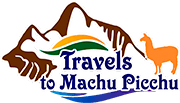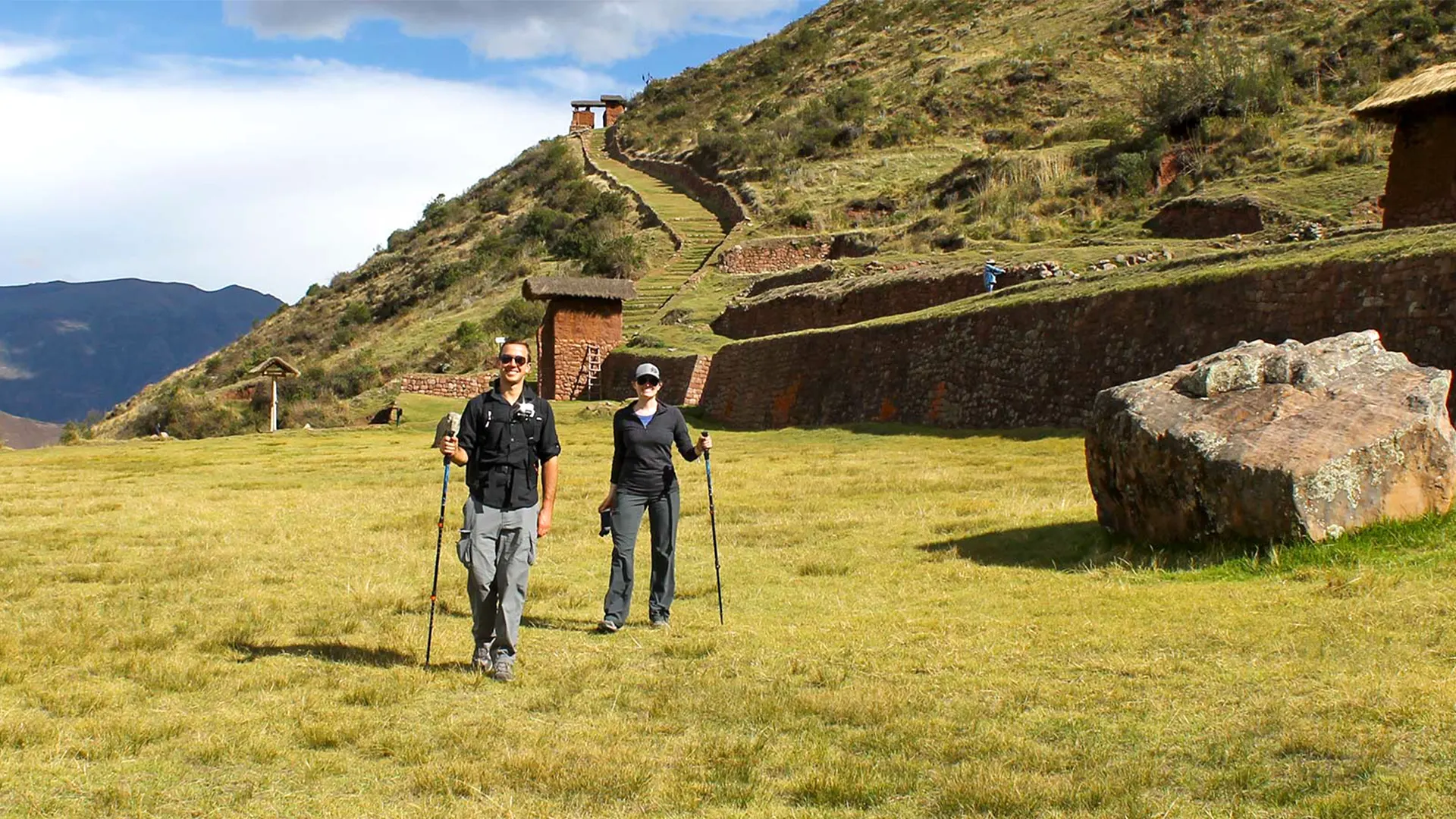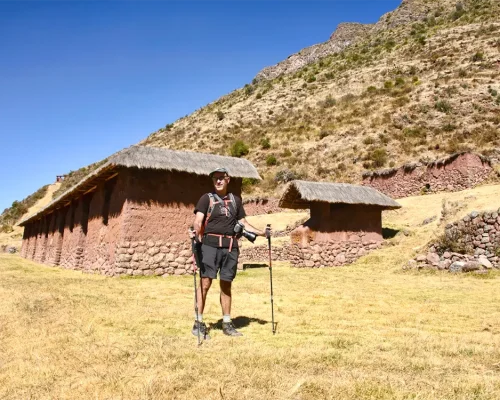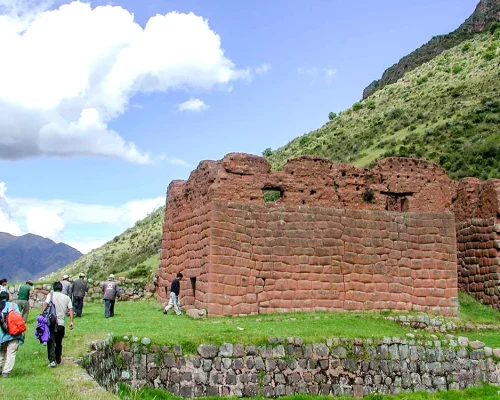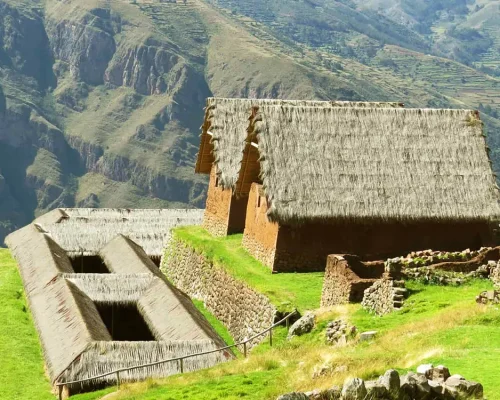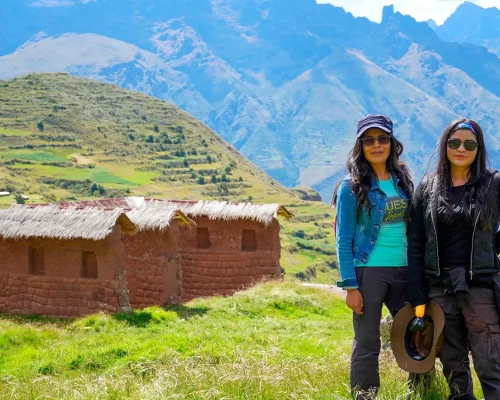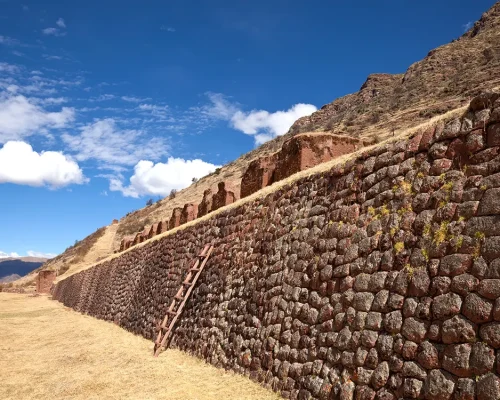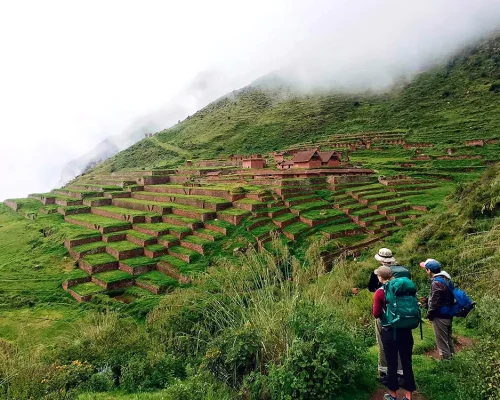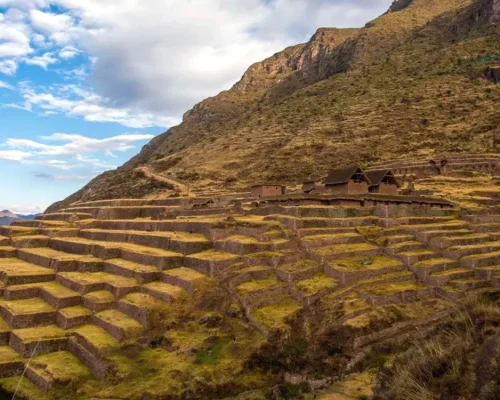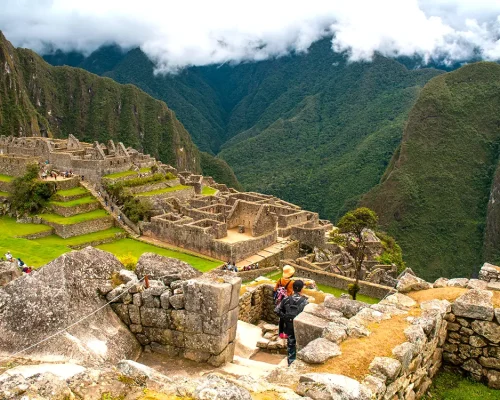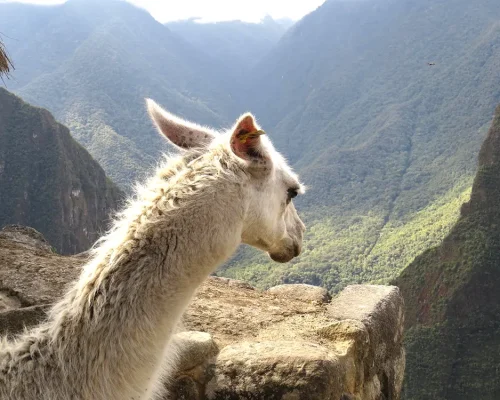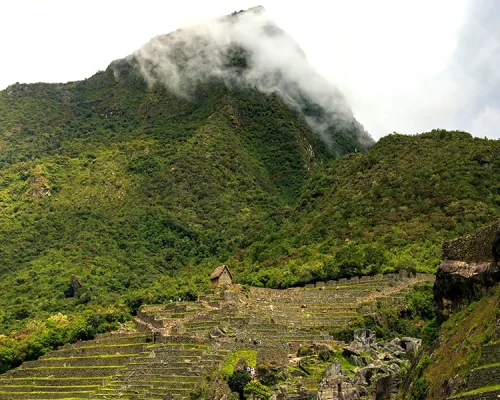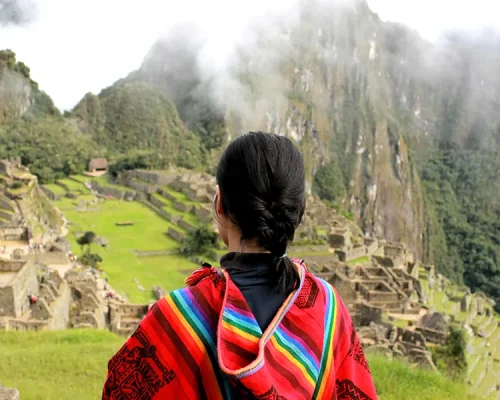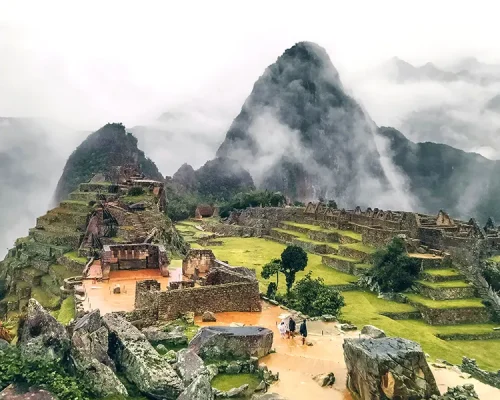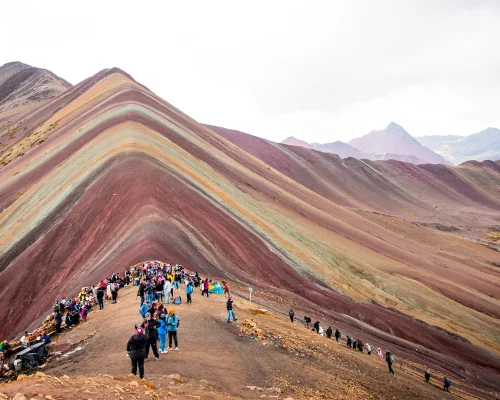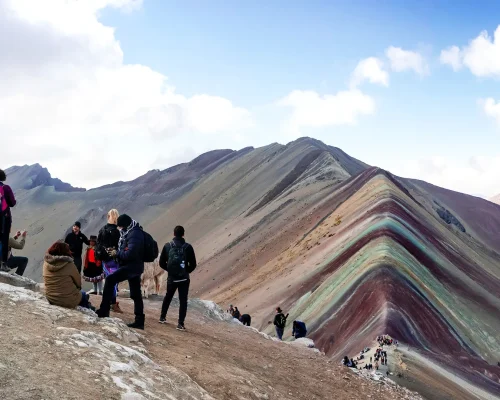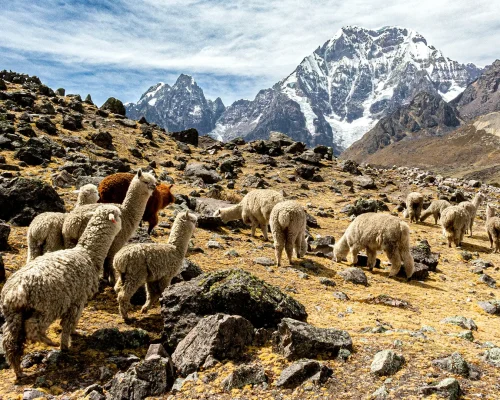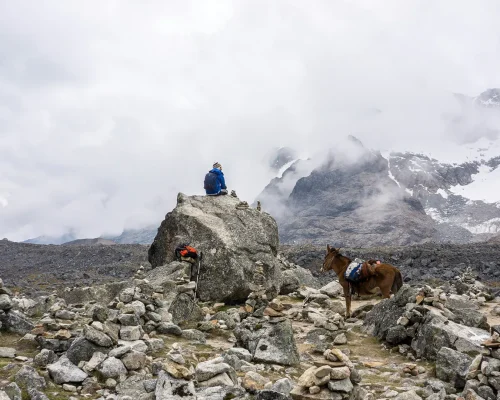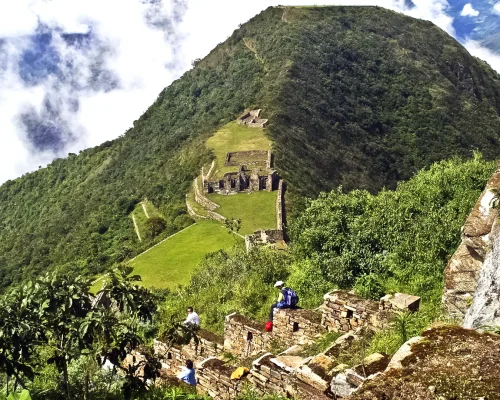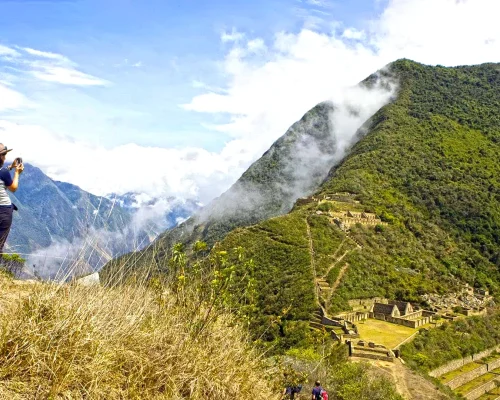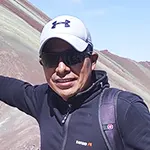Overview
Embark on a breathtaking journey through the heart of the Andes, where every step reveals a rich tapestry of history, culture, and stunning landscapes. This adventure is designed to immerse you in the ancient traditions of the Inca civilization while offering an unforgettable blend of natural beauty and local hospitality.
Throughout the trek, you will experience a perfect mix of challenging hikes and serene moments amid spectacular vistas—from the rugged mountains surrounding Cusco to the mystique of Machu Picchu. Expert guides will accompany you on this culturally enriching expedition, sharing insights about the historical significance of each landmark and ensuring your journey is both safe and deeply rewarding.
Day-by-Day Itinerary
- Day 1: Cusco – Golden Lake – Quencco
- Day 2: Quencco – Huchuyqosqo – Lamay – Ollantaytambo – Aguas Calientes
- Day 3: Aguas Calientes – Machu Picchu – Aguas Calientes – Cusco
Itinerary
Day 1: Cusco – Puca Pucara – Queullacocha Lake – Quencco
We’ll collect you from your hotel at 6:00 a.m. and transfer to the Inca outpost of Puca Pucara (3,700 m), just 20 minutes from Cusco. From there, begin a gentle uphill trek lasting about 1½ hours to reach the first pass at 4,100 m. Here, panoramic views unfold: to your right, the ancient capital of the Incas ringed by the Andes; below you, two hidden archaeological sites in the valley floor; to your left, terraced farmlands and sweeping mountain scenery. Your guide will share insights into the Incas’ arrival, their engineering feats, and the Spanish conquest.
Descending slightly, we follow the valley rim for 45 minutes, crossing a clear mountain stream before arriving at Queullacocha Lake, where lunch is served amid a stark puna landscape covered in resilient Ichu grass. Keep an eye out for Andean geese, lapwings, partridges, and other high-altitude birdlife.
After lunch, continue over a ridgeline and descend to circle Qoricocha Lake (Golden Lake). The 2½-hour walk brings us to the village of Quencco, where warm smiles await. After pitching camp, savor a steaming cup of mate de coca before visiting a local family to learn about their agricultural practices and daily rituals. If you’ve brought small gifts, now is the perfect moment to share them. Return to camp for free time as your guide delves deeper into the Andean way of life under a canopy of stars.
Distance Walked: 14 km
Day 2: Quencco – Huchuy Qosqo – Lamay – Ollantaytambo – Aguas Calientes
Rise to a cup of hot coca tea, pack your gear, and enjoy a wholesome breakfast. Set off toward the mountaintop ruins of Huchuy Qosqo. After about two hours, you’ll join an original section of the Inca Trail just below Pumamarca. Along this stretch, herders tend llamas in a secluded valley microclimate bursting with orchids, ferns, and hummingbirds. As you descend, snow-capped peaks of the Urubamba Range dominate the skyline, offering countless photo opportunities.
Approaching the site, pass through a rustic adobe gateway before arriving at Huchuy Qosqo (3,600 m), aptly named “Little Cusco.” Perched above the Sacred Valley, its sacred temples, storehouses, agricultural terraces, and ancient reservoir reveal the ingenuity of Inca water management. Your guide will lead a detailed tour, then you’ll have time to explore on your own before lunch.
In the afternoon, descend roughly two hours to the riverside village of Lamay (2,800 m), where a private bus transports you to Ollantaytambo. Enjoy dinner at a local eatery, then board the 7 p.m. train to Aguas Calientes. Upon arrival, settle into your hotel and refresh with a hot shower.
Distance Walked: 7 km
Day 3: Aguas Calientes – Machu Picchu – Cusco
Today’s highlight is Machu Picchu. We recommend an early rise to catch one of the first buses (5:30 a.m., first-come, first-served). Upon arrival, your guide will lead you to a prime vantage point to witness the sunrise illuminating the citadel—weather permitting. Then, embark on a two-hour guided tour covering the Intihuatana stone, Temple of the Sun, residential sectors, and more. After the group tour, you’re free to wander the ruins independently or opt to climb Huayna Picchu (separate ticket required) or hike to the Sun Gate for unparalleled views.
Midday, descend by bus to Aguas Calientes for lunch in town, sampling regional specialties. In the afternoon, board the train back to Ollantaytambo, then transfer by bus to Cusco, arriving around 8:00 p.m.
Distance Walked: Approx. 6 km within Machu Picchu complex
Inclusions
Included
- Professional Guides
- Briefing
- Porters
- Transportation
- Equipment
- Food
- Water
- First Aid
- Extras
- Hotel
Not Included
- Sleeping Bag: $20
- Inflatable Air Mattress: $15
- Walking Sticks (Pair): $15
- Headlamps
- Flights
Before You Go
Data about Peru
Peru is a country of great cultural and geographic diversity, located on the western coast of South America. The official language is Spanish, spoken by the majority of the population.
Peru’s official currency is the sol (PEN), which is accepted throughout the country. Additionally, there are many currency exchange houses in the main cities and tourist areas, where travelers can exchange currencies such as the U.S. dollar, the euro, the Japanese yen, among others.
Peru is world-renowned for its rich cultural heritage, spanning from ancient Andean civilizations like the Incas to the Spanish influence that left its mark on the country’s architecture, cuisine, and traditions. Its economy is one of the most dynamic in Latin America, and Peruvian fashion, influenced by its textile traditions, has gained international recognition, especially for its alpaca and innovative designs using natural and sustainable materials.
The climate in Peru varies greatly by region: the coast has a desert climate, the Andean areas are cold, while the Amazon rainforest enjoys a warm and humid climate year-round. Each region has its own charm and is an invitation to explore not only the landscapes but also the cuisine, history, and traditions that make this country a unique destination.
Arriving in Cusco
The Cusco airport is exclusively equipped for domestic flights. Therefore, all international travelers must land in Lima and go through Customs. Although your flight to Cusco may be operated by the same airline and on the same day, you will need to collect your luggage in Lima and recheck it for the flight to Cusco.
Flying is the quickest and most comfortable option to reach Cusco, with several airlines operating this route. While LAN is usually the most expensive, it offers many alternatives and schedules to fit your planning.
Weather in Cusco
The weather in Cusco is primarily temperate and dry, with a rainy season from November to March. During the dry season, from April to October, daytime temperatures are more pleasant, but nights can be cold due to the altitude. Daytime temperatures typically range between 15°C and 20°C, while nighttime temperatures can drop to 0°C or below.
Altitude
When booking a trip to Cusco, it is natural to have concerns about altitude sickness. Cusco’s altitude means that the air contains less oxygen, which forces your body to work harder to obtain the necessary oxygen.
It is recommended that you spend at least two days in Cusco before starting any treks in the Andes to allow your body to acclimate. Cusco is a fascinating city, full of activities, so you won’t be bored during your acclimatization period.
Altitude sickness can initially present with symptoms similar to those of a cold or hangover. Symptoms include headaches, fatigue, loss of appetite, nausea, dizziness, sleep problems, and difficulty breathing during exercise. If symptoms worsen, it is important to contact our office so that we can assist you and arrange for a medical consultation.
Generally, the symptoms are mild, so it is recommended to take things slowly to allow your body to adjust. Stay well hydrated by drinking water or coca tea, which has been used for centuries to prevent the effects of altitude sickness. Coca leaves contain alkaloids that help oxygen circulate in the blood. Avoid excessive consumption of alcohol and coffee, as they dehydrate the body. It is also important to avoid smoking and taking sleeping pills, as these hinder oxygen absorption.
Remember that the trek to Machu Picchu is not a race. Even the fittest individuals can experience altitude sickness if they rush too much. Go slowly and allow your body to adjust to the altitude.
Your doctor may recommend medications such as acetazolamide to prevent altitude sickness, which you should begin taking two days before reaching high altitude.
Group Tours
Group tours may include people with varying hiking abilities and ages. When joining one of these tours, be prepared for the group’s pace to vary, as some participants may move faster or slower than you. Everyone can walk at their own pace, and the guide will work to ensure that everyone enjoys the experience. The groups may request some modifications to the itinerary, and the guide will make the best decisions to ensure everyone’s comfort.
Strikes and Protests
Unfortunately, strikes are common in Peru and can disrupt tour itineraries. Protests may block roads or halt trains. In the event that these issues arise, we will ensure that your itinerary continues as planned, even if this means departing earlier than expected. If it becomes necessary to cancel any tour, our operations team will contact you to coordinate the best possible solutions. The safety of our clients is always our priority.
Lost Items
You are responsible for your belongings throughout the journey. We recommend that you pay attention to where you leave your items and make sure to collect everything from our vans, camps, or restaurants. Do not leave your belongings unattended, as it is possible that other travelers may pick them up without knowing who they belong to.
Travel Insurance
Travel insurance is an affordable and highly recommended option. Although trips are planned months in advance, there is always the possibility of unforeseen events.
Adventure travel carries a higher risk, so having adequate insurance will protect your investment. If you wish, we can help you contact an insurance agent who can advise you on the proper coverage.
First Aid
Every guide from Travels to Machu Picchu has been trained in first aid by medical professionals. We conduct annual training sessions to stay updated and prepared for any emergency. During the tour, each guide carries a first aid kit with basic medications, such as those for traveler’s diarrhea, as well as oxygen.
If you ever feel that you cannot continue the trek, our guides will know the safest and quickest way to get you to a place where you can receive medical attention. We will never leave you alone; there will always be a team member who will accompany you until you are in the hands of a doctor. If necessary, we will ensure that you can visit Machu Picchu at a later time and rejoin your group.
Environmental Impact
At Travels to Machu Picchu, we are committed to respecting the environment. We use biodegradable soap and take care of transporting all our trash back to Cusco. Our porters are trained to take care of the trails and collect any waste they may find from other groups. Additionally, we use eco-friendly portable toilets, which allow us to pack up waste and leave no trace in the natural surroundings. We believe in the importance of practicing responsible and sustainable tourism.
Packing List
Recommendations
- Sturdy Hiking Boots: Well-broken-in, waterproof boots with ankle support to navigate rocky trails and uneven terrain safely.
- Waterproof Rain Jacket: A lightweight, breathable shell to shield you from sudden mountain showers and keep you dry in the puna zone.
- Insulating Layers: Fleece or down jackets that trap warmth during chilly mornings and evenings at high altitude.
- Wide-Brim Sun Hat: Protects face and neck from strong UV rays, especially above 3,500 m where sun exposure is intense.
- Sunscreen & Lip Balm: High SPF sunscreen and moisturizing lip balm to guard against sunburn and wind-chapped skin.
- Hydration System: A 1–2 liter water bladder or insulated bottle to ensure you stay hydrated on long stretches between streams.
- Energy Snacks: Compact, high-calorie treats like nuts, energy bars, or dried fruits to maintain energy levels throughout the trek.
- Trekking Poles: Adjustable poles that reduce strain on knees during ascents and descents, improving overall stability.
- Headlamp with Extra Batteries: Essential for pre-dawn starts, campsite tasks, and exploring Machu Picchu before sunrise.
- Quick-Dry Clothing: Synthetic shirts and pants that wick moisture and dry rapidly after laundry or rain.
- Extra Socks: At least two pairs of moisture-wicking socks to prevent blisters and keep feet comfortable.
- Personal First-Aid Kit: Include blister pads, pain relievers, altitude sickness tablets, and any personal medications.
- Compact Daypack: A 20–30 liter pack for carrying water, snacks, camera, and extra layers during daily hikes.
- Insect Repellent: Sweat-resistant repellent to guard against biting insects in lower valley areas and near water sources.
- Portable Power Bank: Keeps phone and camera batteries charged for capturing memories and staying in touch.
Price
Join us on this unforgettable 3-day adventure along Huchuy Qosqo for USD 500 per person. This price includes everything you need for a seamless and memorable experience: transportation, professional guides, permits, food, and more.
Please note that this tour requires a minimum of two participants. Gather your friends or family and embark on this incredible journey together!
Frequently Asked Questions
Huchuy Qosqo Trek 3D/2N: What does the package include?
Includes services designed for you to enjoy without worries. Certified professional guide (Spanish/English), briefing in Cusco, porters for camp logistics, private transport as per the itinerary (Cusco → Puca Pucara, Lamay → Ollantaytambo, return Ollantaytambo → Cusco), train Ollantaytambo ↔ Aguas Calientes, camping equipment (dining tent, kitchen, shelter), meals during the trek as per itinerary, treated water to refill your water bottle, first aid kit and oxygen, plus accommodation in Aguas Calientes on night 2. Everything is coordinated for a safe and enriching experience.
Huchuy Qosqo Trek: What is not included and optional costs?
To help you plan your budget, keep in mind that the following are not included:
- Sleeping bag (optional rental).
- Inflatable mattress or extra-comfort (optional rental).
- Trekking poles (optional rental).
- Headlamp (recommended, you can bring your own).
- Domestic/international flights.
- Meals not specified in Aguas Calientes.
- Entry to Huayna Picchu or Machu Picchu Mountain (optional and subject to availability).
- Travel insurance, tips, and personal expenses.
If you need to rent equipment, let us know in advance to reserve it. Extras are subject to availability.
Huchuy Qosqo Trek 3D/2N: Difficulty, Altitude, and Distances
It is a route of moderate difficulty, ideal for travelers with basic to intermediate fitness. Approximate altitudes and distances:
- Day 1: Puca Pucara (3,700 m) → pass 4,100 m → camp in Quencco. Approx. distance: 14 km.
- Day 2: Quencco → Huchuy Qosqo (3,600 m) → Lamay (2,800 m) → train to Aguas Calientes. Approx. distance: 7 km.
- Day 3: Guided tour of Machu Picchu and internal walks approx. 6 km.
We recommend acclimating for 1-2 nights in Cusco before starting and maintaining a steady pace, hydration, and light meals.
Best Time for the Huchuy Qosqo Trek and Weather in Cusco
The dry season (April to October) offers more stable skies and cold nights; the rainy season (November to March) presents rainfall and greener landscapes. Typical temperatures in Cusco: 15–20 °C by day and 0 °C or lower at night at altitude. Always bring thermal layers and waterproofs. If traveling in peak season (June–August), book in advance due to high demand for trains and tickets.
Huchuy Qosqo Trek 3D/2N Itinerary: How does each day unfold?
Summary day by day:
- Day 1: Cusco → Puca Pucara → Laguna Queullacocha → Qoricocha → camp in Quencco. Andean views, highland fauna, and cultural experience with local families.
- Day 2: Quencco → Huchuy Qosqo (guided tour of terraces, warehouses, and temple) → descent to Lamay → transport to Ollantaytambo → train to Aguas Calientes.
- Day 3: Early bus to Machu Picchu, 2-hour guided tour, free time or options (Huayna Picchu/Sun Gate), return by train and bus to Cusco.
This itinerary balances Inca culture, landscapes, and comfort, optimizing time to enjoy each stop.
Machu Picchu in the Program: Entry, Hours, and Visit Time
On day 3, we take the first buses (from ~5:30 a.m.) to take advantage of the morning light. Includes a ~2-hour guided tour of the main temples and sectors and free time afterward. Consider that:
- Tickets have a assigned entry time and defined circuits by the authorities.
- For Huayna Picchu or Machu Picchu Mountain an additional ticket is required with fixed hours and limited availability.
- No restrooms inside the citadel (only at the entrance).
Our team handles logistics so you get the most out of your visit.
Accommodation and Equipment on the Huchuy Qosqo Trek: Camp and Hotel
You will sleep 1 night in camp (Quencco, Day 1) with group tents and full logistics, and 1 night in a hotel in Aguas Calientes (Day 2) with a bathroom and hot shower. We provide quality tents; the sleeping bag and inflatable mattress can be rented if you don’t bring them. In Aguas Calientes, you will have comforts to rest before Machu Picchu.
Meals on the Huchuy Qosqo Trek: Menus and Special Diets
During the trek, we serve nutritious and balanced meals prepared by our team (breakfast, lunch, and dinner as per the itinerary). We accommodate vegetarian, vegan, or restrictive diets (gluten, lactose) at no additional cost, with 48–72 hours’ notice. We provide treated water to refill your bottle. In Aguas Calientes, you can choose from local dishes and international options.
Luggage on the Huchuy Qosqo Trek: What to Bring and How Much Weight?
We suggest bringing:
- Daypack (20–30 L) with water, snacks, camera, waterproofs, and layers.
- Bag/duffel for camp with personal gear (sleeping bag, warm clothing, hygiene items).
The transport of cargo is supported by porters. The weight limit may vary depending on the group and season; as a reference, try to travel light (5–7 kg) in the duffel. Let us know if you need extra capacity. Keep valuables and documents with you at all times.
Health and Safety: Altitude Sickness and First Aid on the Huchuy Qosqo Trek
The altitude may cause headache, nausea, or fatigue. We recommend:
- Acclimate for 1–2 days in Cusco before the trek.
- Stay hydrated and avoid alcohol and sedatives.
- Consume coca tea/leaves and light foods.
Our guides are first aid certified and carry first aid kits and oxygen. If you feel unwell, we will adjust the pace or arrange medical attention. Consult your doctor about acetazolamide if you think it necessary.
Essential Checklist for the Huchuy Qosqo Trek: Recommended Clothing and Gear
To stay comfortable and safe, bring:
- Waterproof trekking boots and well-fitted.
- Thermal layers (fleece/down) and light waterproofs.
- Quick-drying clothing, hat/visor, and sunblock.
- Trekking poles (recommended for ascents/descents).
- Headlamp, gloves, and extra socks.
- Energy snacks and water bottle/hydration bag (1–2 L).
- Repellent, personal first aid kit, and external battery.
These items make a big difference in your daily comfort.
Huchuy Qosqo: What Will We See and Why Is It a Special Site?
Huchuy Qosqo, the “Little Cusco,” rises above the Sacred Valley and preserves agricultural terraces, storage rooms (qollqas), temples, and an ancient reservoir that reflect Inca hydraulic engineering. From its viewpoints, you will have privileged views of the Urubamba Mountain Range and the “heart” of the valley. Our guide will provide historical context and free time for photos and exploration.
Rules and Tips for Machu Picchu: Permitted Items and Behavior
To care for the sanctuary:
- Avoid drones, large tripods, and selfie sticks (these are often restricted).
- No eating or smoking inside the citadel.
- Keep your passport and ticket handy; respect the assigned circuit.
- Restrooms are outside the entrance area; use them before entering.
Respect signage and guide recommendations for a safe and responsible experience.
Logistics of Day 3: Buses, Trains, and Return to Cusco
On day 3, we take the bus from Aguas Calientes to Machu Picchu for the guided tour. Then, we return to Aguas Calientes for lunch, and in the afternoon, we take the train to Ollantaytambo. From there, a private transport will take you to Cusco, arriving around 8:00 p.m. Our team coordinates confirmed times and will assist with any operational changes.
Strikes, Weather, and Contingencies on the Huchuy Qosqo Trek
In Peru, strikes or roadblocks may affect roads or trains. We prioritize your safety and may adjust schedules or routes to fulfill the itinerary when feasible. In case of bad weather, the guide will decide the best operational alternative. If any service needs to be canceled, our team will propose the most convenient solution available according to supplier policies.
Reservations, Payments, and Cancellations for the Huchuy Qosqo Trek 3D/2N
We recommend booking in advance, especially during the high season. To confirm, a deposit is required; the balance can be paid in Cusco by available means. Change and cancellation policies depend on notice and third parties (trains/tickets), so penalties may apply. We will send you the current conditions at the time of quoting for full transparency.
Optional: Huayna Picchu or Machu Picchu Mountain during the Trek
Both are optional, with limited spots and fixed hours. If you wish to add:
- Huayna Picchu: steep trail, iconic views, reduced capacity.
- Machu Picchu Mountain: longer and more panoramic, less crowded.
You must request the additional ticket when booking. Our team will confirm availability and adjust your visit time within the limits of the official circuits.
Services on the Route: Restrooms, Water, and Device Charging on the Huchuy Qosqo Trek
During the trek, we use eco-friendly portable restrooms and minimize environmental impact. We provide treated water to refill bottles at specific points. Electricity at camp is limited; we suggest bringing an external battery. In Aguas Calientes, you’ll have hot showers, restaurants, and better connectivity to recharge devices.
Enquire Now
Thank you for considering Travels to Machu Picchu for your next adventure in Peru. To provide you with a tailored experience, we invite you to fill out our short form. One of our travel advisors will provide you with all the information you need to enjoy an unforgettable journey.
Your Privacy is Our Priority
At Travels to Machu Picchu, we protect your personal information. We do not share, sell, or disclose your data to third parties under any circumstances.
